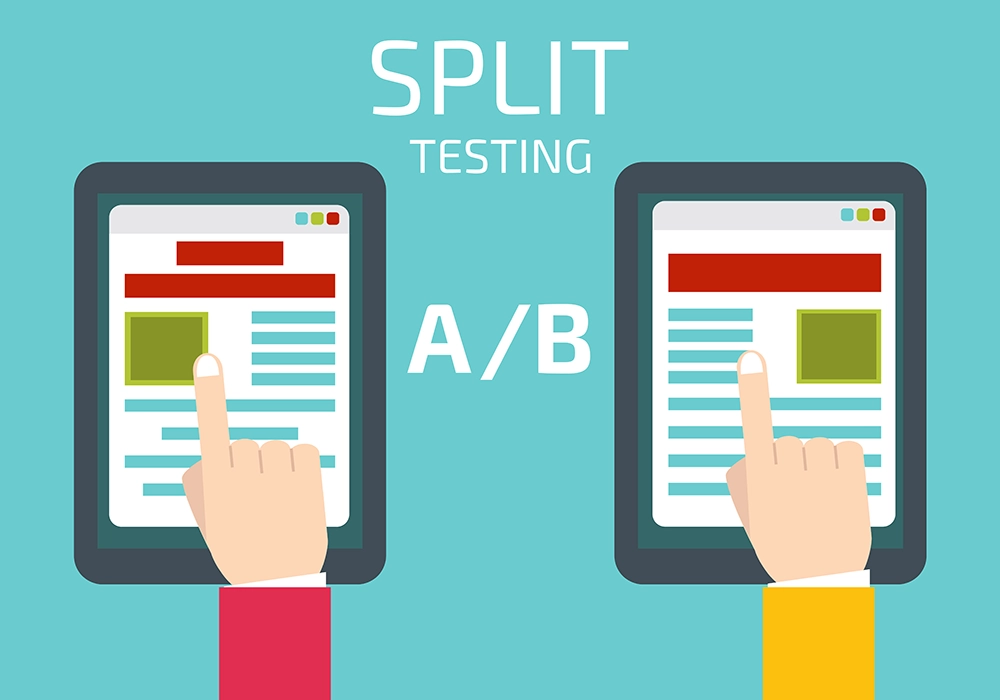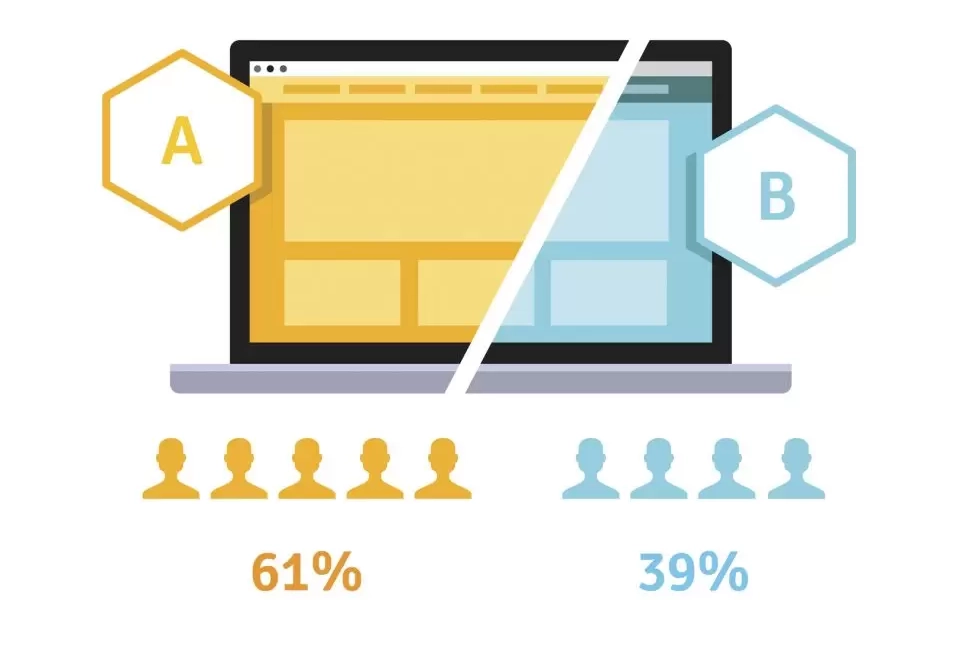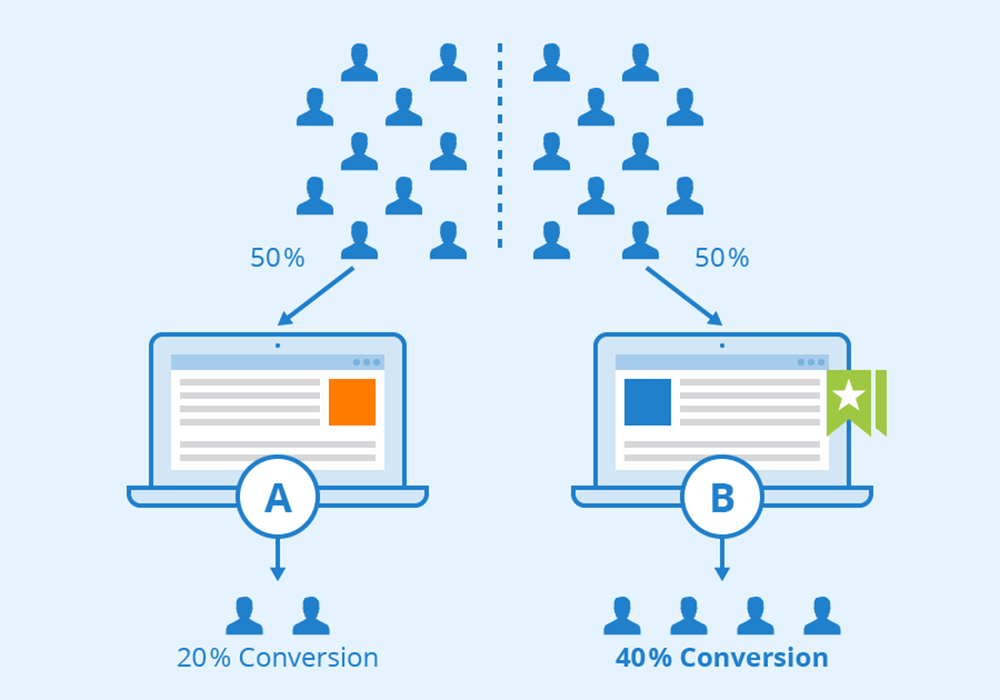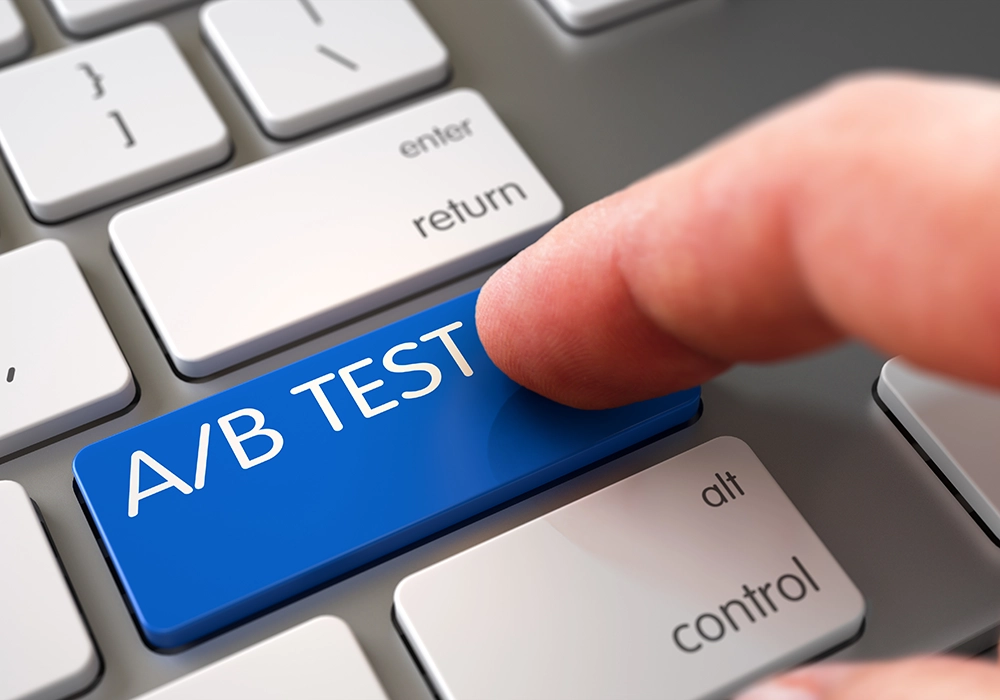A/B testing, or split testing, is a powerful tool for optimizing website conversion rates. However, it’s not enough to test different web page versions; personalization techniques must be incorporated to achieve optimal results.
Personalization goes beyond split testing to create unique, tailored experiences for each visitor. These experiences cater to targeted audience segments’ specific needs, preferences, and behaviors, creating a more optimized user experience and boosting conversion rates.
In this article, we’ll explore the benefits of personalization in the context of A/B testing and delve into various techniques for leveraging personalization to achieve superior results. From data-driven experimentation to machine learning algorithms, we’ll cover the strategies and best practices for maximizing the effectiveness of A/B testing through personalization.

Key Takeaways:
- Personalization is essential for achieving optimal A/B testing results.
- By creating tailored experiences for targeted audience segments, personalization can boost conversion rates and optimize the user experience.
- Data-driven experimentation and machine learning algorithms are just a few techniques for leveraging personalization in A/B testing.
- Creating a testing plan, implementing best practices, and analyzing results are crucial for effective personalization and A/B testing.
- The potential benefits of personalization are significant, and marketers should strive to leverage its power for better results.
Understanding A/B Testing and Its Benefits
A/B Testing is an integral part of digital marketing that involves comparing two web page versions to determine which performs better. The process involves testing the changes made to a single element of a website against the original version to identify the one that generates more traffic, leads, or conversions.
The primary benefit of A/B Testing is that it allows businesses to optimize their web pages for better conversion rates. It helps identify the elements influencing user behavior and enables marketers to create a personalized user experience. With A/B Testing, businesses can test different variations of their web pages and achieve statistical significance to make data-based decisions.
Testing tools are essential in facilitating A/B Testing and optimizing conversion rates. These tools help create and implement personalized testing plans, compare different versions of web pages, and analyze the results. Achieving statistical significance is crucial to ensure that the results obtained from the testing process are reliable and accurate.
Optimizing Conversion Rates through Systematic Testing
A/B Testing is an effective way of optimizing conversion rates through systematic testing. It involves testing small changes to web pages likely to influence user behavior. This could be changed to the headline, text, images, call-to-action buttons, or web page layout.
Optimization is a continuous process since user behavior is constantly evolving. Consequently, it is essential to regularly test variations of web pages to identify those that generate the best results. A/B Testing helps businesses improve their website’s conversion rates and engagement with the audience.
| Benefits of A/B Testing |
|---|
| Optimized user experience |
| Informed decision-making based on data |
| Increased click-through-rates |
| Better engagement with the target audience |
| Improved conversion rates |
Statistical significance is crucial in interpreting the results of A/B Testing. Based on the data collected, it helps determine whether a variation is better than the original version. If the difference in results between the two versions is not statistically significant, it won’t be easy to make data-based decisions.

Ultimately, A/B Testing is a powerful tool enabling businesses to optimize their online presence and improve conversion rates. With the right testing tools, best practices, and strategies, businesses can create a personalized user experience that resonates with their target audience, boosts their website’s performance, and generates higher revenue.
The Role of Personalization in A/B Testing
Personalization is a critical factor in creating a successful A/B Testing strategy. It allows marketers to tailor their messaging and website experiences to specific audiences, improving user engagement and conversion rates. By leveraging predictive personalization, marketers can create personalized experiences that match their target audience’s unique preferences and needs.
The Benefits of Personalization
The benefits of personalization are numerous. Marketers can improve user engagement by segmenting the target audience and tailoring their experience to these segments, driving excellent conversion rates and bolstering customer loyalty. The more personalized the experience, the more likely users are to return to the site for future purchases, generating long-term value for the brand.

Segmentation and Understanding the Target Audience
Segmenting the target audience requires understanding their needs, wants, and desires. Marketers can develop a deep understanding of their target audience by collecting and analyzing data such as user behavior and demographics. With this knowledge, they can create targeted personalization strategies that deliver the best results.
Creating Personalized Experiences
To create personalized experiences, marketers need to use data to inform their decision-making. This means testing and experimenting with personalized elements like message copy, imagery, and calls to action. By conducting personalized A/B Testing, brands can identify the best-performing elements unique to each segment.
Leveraging Data for Personalization
Personalization is crucial to A/B testing and can be optimized using demographic and user behavior data. Analyzing data points such as age, gender, education, and life stages can help create personalized segments to cater to each group’s specific needs.
Testing methods such as multivariate and predictive personalization also require data to test personalized experiences against a control group to create a variation that resonates with the audience.
For example, a study showed that personalizing the language on a website based on demographics led to an 8% increase in conversions. Similarly, understanding user behavior data, such as click-through rates, browsing history, and search queries, can help create more effective personalization experiments.
“Data is the key to unlocking the door to personalization. Without it, we’re just guessing.”
Implementing Personalization Techniques
Personalization tests can be tricky, especially when figuring out which methods work the best for your audience. Luckily, you can use several personalization techniques to make your A/B tests shine.
Social Proof
Social proof is a powerful tool for influencing customer behavior. By showing potential customers that others have already had a positive experience with your product or service, you can create a sense of trust and credibility that can help boost conversion rates.
One way to incorporate social proof into your A/B tests is by adding reviews and ratings to your product pages. Another option is to display the number of people who have bought a particular item.
Machine Learning
Machine learning algorithms can analyze user behavior and provide personalized experiences based on past interactions. By tracking and processing customer preferences and behavior data, you can create more relevant and engaging content for your audience that will drive conversions and increase engagement.

Rule-based Personalization Tests
Rule-based personalization tests involve setting up rules to determine how a website or app content is displayed to different users. For example, you might show different offers to visitors based on their geographic location or browsing history.
These tests can be highly effective for providing more tailored experiences to individual users, which can help boost engagement and conversion rates.
Personalizing the Shopping Cart Experience
The shopping cart experience is a critical part of the online sales process. Personalizing the shopping cart experience can help reduce cart abandonment rates and drive sales.
One way to personalize the shopping cart experience is by offering personalized product recommendations based on a user’s purchase history or browsing behavior. You can also highlight limited-time promotions or incentives to encourage users to complete their purchases.
Optimizing A/B Testing with Multivariate and Predictive Personalization
Multivariate testing and predictive personalization offer advanced strategies that can dramatically improve results for marketers looking to get the most out of their A/B testing efforts.
When it comes to multivariate testing, the goal is to test changes to multiple elements of a webpage or marketing campaign simultaneously to identify the best-performing combination. With different versions of a landing page or ad being tested alongside one another, marketers can quickly identify changes that positively impact conversion rates and user engagement.
Meanwhile, predictive personalization takes things a step further, using machine learning algorithms to create personalized experiences for each user. By analyzing data on user behavior, demographics, and other factors, predictive personalization can anticipate the needs and preferences of each user, delivering a tailored experience that is more likely to result in conversions.
Using Multivariate Testing to Find the Best Performing Elements
| Element | Version 1 | Version 2 | Conversion Rate |
|---|---|---|---|
| Headline | “Discover Your Dream Job” | “Find Your Perfect Career” | 8% |
| Call to Action | “Apply Now” | “Get Started” | 12% |
| Image | Woman smiling | Man working | 10% |
As shown in the table above, multivariate testing allows marketers to test different versions of individual elements of a webpage or campaign, in order to identify the best-performing option for each. By analyzing data on conversion rates, marketers can quickly optimize their campaigns for maximum results.
Using Predictive Personalization to Cater to Your Audience
Predictive personalization takes things one step further, using machine learning algorithms to create personalized experiences that are tailored to individual users. By analyzing data on user behavior, demographics, and other factors, predictive personalization can anticipate the needs and preferences of each user, delivering a personalized experience that is more likely to result in conversions.
For example, if a user frequently browses products in a certain category, a website can use predictive personalization to show them customized content and offers related to that category. By catering to the user’s interests, the website can create a more engaging and personalized experience that is more likely to lead to a conversion.
In conclusion, multivariate testing and predictive personalization are advanced techniques that can help marketers optimize their A/B testing efforts and generate better results. By using these strategies to create tailor-made experiences that cater to their audience, marketers can improve user engagement, boost conversion rates, and maximize their return on investment.
Best Practices and Strategies for Effective Personalization
Personalization is only as effective as the strategy behind it. A solid testing plan must be in place to ensure optimal results. Identifying the audience segments and aligning personalization efforts with marketing strategies are key. And with the increasing use of mobile apps, it’s important to tune the personalization experience to meet the specific needs of mobile users for best results.
Creating a Testing Plan
Before running a personalized A/B test, it’s important to have a testing plan in place. This plan should outline the objectives of the test, the target audience, and the metrics that will be used to measure the results. By having a well-defined testing plan, it’s easier to execute the test and interpret the results accurately.
Implementing Best Practices
To ensure optimal results, it’s crucial to implement best practices when testing with personalization. This includes using industry standards for testing, implementing proper tracking, and adhering to ethical guidelines. By implementing best practices, you’ll be able to increase the accuracy of your testing and ensure that your results are reliable.
Aligning Personalization with Marketing Strategies
Personalization is only effective when it’s aligned with your marketing strategies. You need to identify the audience segments that are most relevant to your marketing objectives and personalize their experiences accordingly. This not only improves the user experience but also drives higher conversion rates and better ROI.
Personalizing the Mobile App Experience
With the increasing use of mobile devices, it’s important to ensure that your personalization efforts are optimized for mobile users. This includes streamlining the user experience, optimizing the content for smaller screens, and ensuring that the personalization experience is consistent across different devices. By doing so, you’ll be able to maximize the impact of your personalization efforts and improve your results.
Analyzing Results and Measuring ROI
Measuring the results of your A/B tests is crucial to determine whether the changes made have had a positive impact on your website’s performance. Data points such as click-through rates and conversion rate optimization can provide valuable insights into the effectiveness of your tests and whether they need refinement or further implementation.
To boost your results, be sure to test personalized variations and create variations that can enhance the user experience. The goal is to not only improve conversion rates but also retain customers in the long run by providing them with a tailored experience that meets their specific needs.
| Metric | What it means | How to improve it |
|---|---|---|
| Click-through rate | The percentage of users who click through to a specific page or link | Try different calls-to-action, wording, or button placements to encourage more clicks. |
| Conversion rate optimization | The percentage of users who complete the desired action on a page | Create variations that cater to the target audience’s needs, and test them to determine what works best. |
| Data points | Specific pieces of information that can provide insights into user behavior or preferences | Analyze these data points to identify patterns and trends that can guide further personalization efforts. |
Using these methods, you can track progress and measure the ROI of your personalization efforts. By analyzing results and fine-tuning your A/B testing strategy, you can improve your conversion rates and provide an optimized user experience. Personalization can help take your A/B testing to the next level, helping you achieve the best results possible.

Conclusion
It is clear that incorporating personalization techniques into A/B Testing can have a significant impact on conversion rates, user experience, and optimization. By segmenting your audience and leveraging data to create personalized experiences, you can cater to the specific needs of your customers and create an emotional connection with your brand.
While A/B Testing is a valuable tool in its own right, the addition of personalization techniques can take your efforts to the next level. Multivariate testing and predictive personalization offer advanced strategies for optimizing your results, while best practices and effective testing plans can help ensure that you’re on the right track.
Ultimately, the benefits of personalization far outweigh any additional effort required to implement it. By boosting your conversion rates and improving your user experience, you’ll be able to achieve your digital marketing goals with greater ease and efficiency. So why not take advantage of this powerful tool and see the results for yourself? Start incorporating personalization into your A/B Testing today and watch as your business thrives.
FAQ
What is A/B Testing and why is it important?
A/B Testing is a method used by marketers to compare and evaluate two versions of a webpage or campaign to determine which one performs better in terms of conversion rates. It is important because it allows marketers to optimize their strategies and achieve higher conversion rates through data-driven decision making.
How does personalization enhance A/B Testing?
Personalization enhances A/B Testing by tailoring the user experience to specific segments of the target audience. By delivering personalized experiences, marketers can increase user engagement, boost conversion rates, and improve overall customer satisfaction.
What is predictive personalization?
Predictive personalization is a technique that uses machine learning algorithms to analyze user behavior and predict the most effective content or offers. It helps marketers to anticipate and cater to individual preferences, increasing the chances of a conversion.
How can segmentation improve A/B Testing?
Segmentation involves dividing the target audience into distinct groups based on common characteristics such as demographics, preferences, or behavior. By segmenting the audience, marketers can create personalized experiences for each group and achieve better results through targeted messaging and optimization.
How can data be leveraged for personalization in A/B Testing?
Data, such as demographics and user behavior, can be used to create personalized experiments in A/B Testing. By analyzing this data, marketers can identify trends, preferences, and patterns, allowing them to create customized experiences that resonate with their target audience.
What is the significance of social proof in personalization?
Social proof refers to the influence exerted by the actions and opinions of others on an individual’s behavior. Incorporating social proof elements, such as testimonials, reviews, or social media endorsements, in personalized experiences can increase trust, credibility, and conversion rates.
Can A/B Testing and personalization be used together?
Yes, A/B Testing and personalization can be used together to enhance marketing strategies. By combining these techniques, marketers can test multiple variations of personalized experiences and identify the most effective elements. This iterative process allows for continuous optimization and improved conversion results.
How can I measure the success of personalization in A/B Testing?
To measure the success of personalization in A/B Testing, you can track metrics such as click-through rates, conversion rates, average order value, and overall return on investment (ROI). These metrics provide insights into the impact of personalization on the performance of your campaigns.
What are some best practices for effective personalization in A/B Testing?
Some best practices for effective personalization in A/B Testing include predefining target segments, creating variations for each audience segment, using data to inform personalization strategies, and running tests for a sufficient duration to ensure statistically significant results. It is also important to constantly analyze and refine your personalization efforts based on the data.
How can personalization boost results and improve ROI?
Personalization can boost results and improve ROI by delivering tailored experiences that resonate with the target audience. By catering to individual preferences and needs, marketers can increase engagement, conversion rates, and customer satisfaction, ultimately driving more revenue and maximizing the return on investment.




Leave a Reply